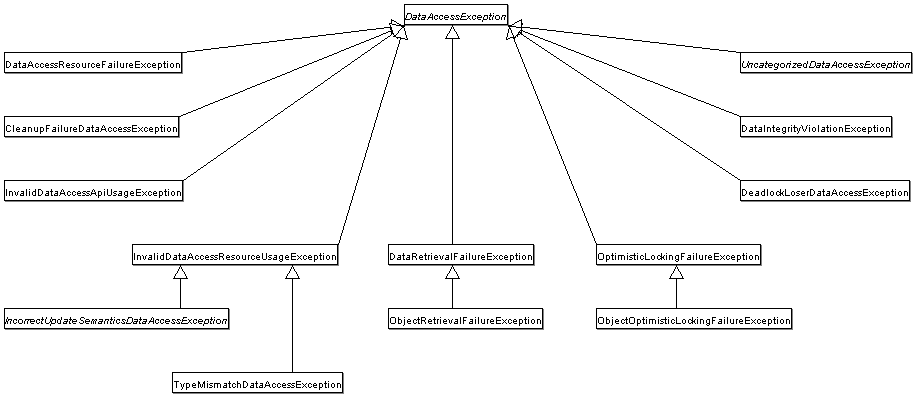The Data Access Object (DAO) support in Spring is aimed at making it easy to work with data access technologies like JDBC, Hibernate, JPA or JDO in a consistent way. This allows one to switch between the aforementioned persistence technologies fairly easily and it also allows one to code without worrying about catching exceptions that are specific to each technology.
Spring provides a convenient translation from technology-specific exceptions like
SQLException to its own exception class hierarchy with the DataAccessException as
the root exception. These exceptions wrap the original exception so there is never any
risk that one might lose any information as to what might have gone wrong.
In addition to JDBC exceptions, Spring can also wrap Hibernate-specific exceptions, converting them to a set of focused runtime exceptions (the same is true for JDO and JPA exceptions). This allows one to handle most persistence exceptions, which are non-recoverable, only in the appropriate layers, without having annoying boilerplate catch-and-throw blocks and exception declarations in one’s DAOs. (One can still trap and handle exceptions anywhere one needs to though.) As mentioned above, JDBC exceptions (including database-specific dialects) are also converted to the same hierarchy, meaning that one can perform some operations with JDBC within a consistent programming model.
The above holds true for the various template classes in Springs support for various ORM
frameworks. If one uses the interceptor-based classes then the application must care
about handling HibernateExceptions and JDOExceptions itself, preferably via
delegating to SessionFactoryUtils’ `convertHibernateAccessException(..) or
convertJdoAccessException() methods respectively. These methods convert the exceptions
to ones that are compatible with the exceptions in the org.springframework.dao
exception hierarchy. As JDOExceptions are unchecked, they can simply get thrown too,
sacrificing generic DAO abstraction in terms of exceptions though.
The exception hierarchy that Spring provides can be seen below. (Please note that the
class hierarchy detailed in the image shows only a subset of the entire
DataAccessException hierarchy.)

The best way to guarantee that your Data Access Objects (DAOs) or repositories provide
exception translation is to use the @Repository annotation. This annotation also
allows the component scanning support to find and configure your DAOs and repositories
without having to provide XML configuration entries for them.
@Repository public class SomeMovieFinder implements MovieFinder { // ... }
Any DAO or repository implementation will need to access to a persistence resource,
depending on the persistence technology used; for example, a JDBC-based repository will
need access to a JDBC DataSource; a JPA-based repository will need access to an
EntityManager. The easiest way to accomplish this is to have this resource dependency
injected using one of the @Autowired,, @Inject, @Resource or @PersistenceContext
annotations. Here is an example for a JPA repository:
@Repository public class JpaMovieFinder implements MovieFinder { @PersistenceContext private EntityManager entityManager; // ... }
If you are using the classic Hibernate APIs than you can inject the SessionFactory:
@Repository public class HibernateMovieFinder implements MovieFinder { private SessionFactory sessionFactory; @Autowired public void setSessionFactory(SessionFactory sessionFactory) { this.sessionFactory = sessionFactory; } // ... }
Last example we will show here is for typical JDBC support. You would have the
DataSource injected into an initialization method where you would create a
JdbcTemplate and other data access support classes like SimpleJdbcCall etc using
this DataSource.
@Repository public class JdbcMovieFinder implements MovieFinder { private JdbcTemplate jdbcTemplate; @Autowired public void init(DataSource dataSource) { this.jdbcTemplate = new JdbcTemplate(dataSource); } // ... }
![[Note]](images/note.png) | Note |
|---|---|
|
Please see the specific coverage of each persistence technology for details on how to configure the application context to take advantage of these annotations. |